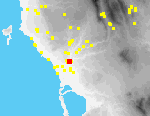 C01 Tragana Alafinorema
C01 Tragana Alafinorema
Site C1 is located on the terraced E and S slopes of a marl spur some 700 m. ENE of the modern village of Tragana[088.30]. A mound at the crest of the spur marks the northern end of the site; dirt roads bound it to the SE and SW. There is an excellent view of the Alafinorema valley, to the NE. Younger olives are interspersed with older mature trees.[093.34]
The mound is covered by brambles and weeds and a rubble terrace wall supports it at the S.[093.33] At the time of gridded collection of the site in 1992 virtually all artifacts were collected from the slopes beneath the mound. Between the summers of 1992 and 1993, however, a part of the mound covered with inpenetrable maquis was deep-plowed and levelled to create a short terrace at its SW side. In the process, many artifacts were brought to the surface on and near the mound itself, thus suggesting the possibility that artifacts on the slopes have eroded from this source.
This hypothesis is not contradicted by the results of follow-up geological investigations in 1993. Five cores were extracted perpendicular to the slope at 10 m. intervals. In a core taken in the mound N of the rubble wall, a buried soil unit with a noticeable anthropogenic impact, but containing few diagnostic artifacts, was reached at a depth of 0.7-1.3 m. This unit could not be traced in adjacent cores. In the area of the mound at least, it is clear, however, that soil creep has concealed part of the site.
Sherds identified as prehistoric or archaic-classical came largely from the northern edge of the site, on and around the mound, but some were also collected 30-40 m. downslope. In contrast, Byzantine - Turkish sherds, including cookwares, were found almost everywhere on the site.
Although some early sherds were collected at this site, the predominant range of ceramics at Alafinorema is Turkish-Early Modern. This reading is based on the large number of glazed tablewares from this period as well as plain and coarse wares. Earlier periods, however, are represented, including: MH-LH, Archaic-Classical, and Roman-Byzantine. These earlier diagnostic sherds are but a small proportion of the ceramics collected at this site. Sherds identified as prehistoric or Archaic-Classical came from the northern edge of the site and [from grid square 212]. Byzantine-Turkish sherds were more universally distributed across the site. Vessel types included true Classical fine wares (such as C92-91143-1), Byzantine table wares (such as C92-91312-1), and Early Modern glazed vessels. Cookwares were also widespread.